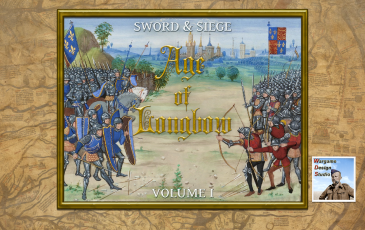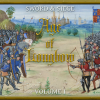011.Morlaix_a_WBS - Historical - WDS Age of Longbow Volume I

 0 - 0 - 0
0 - 0 - 0

| Rating: | 0 (0) |
| Games Played: | 0 |
| SM: | 1 |
| Turns: | 15 |
| Type: | Stock |
| First Side: | Side_A (ALB1) |
| Second Side: | Side_B (ALB1) |
Date: 30 September 1342 - Size: Small - Location: Morlaix, Finistère Dept, Brittany, France
Scenario Briefing: Historical - Brittany was one of the key theatres during the initial stage of the Hundred Years War. The rival claimants to the Duchy in the War of the Breton Succession (1341-1365) were Montfort (supported by England) and Blois (backed by France). After an English naval victory at Brest in August 1342, a small English army under the Earl of Northampton moved inland to besiege the Blois-faction controlled Morlaix. The approach of a larger Franco-Breton force compelled Northampton to abandon the siege and retreat to a suitable defensive position in preparation for battle. Before the enemy arrived, there was sufficient time to dig defensive pits to protect the archers and flanks of the army from the French cavalry.
The three contemporary accounts of the battle - le Baker, Knighton and Murimuth - are all English and none of them provide a very clear account of exactly what happened. The English may have deployed with the archers on the flanks or possibly mixed in with the other troops. The French were deployed in three lines and Murimuth states that there were "trium millium armatorum, et mille quingentorum Januencium et popularium sine numero." Presumably, the 3,000 armored men fought mounted and the 1,500 "Januencium" were Genoese crossbowmen. Exactly how numerous the "popularium" were or how they were armed is a matter of mere guesswork.
Modern historians, except Burne, tend to conjecture that the Franco-Blois cavalry launched an initial frontal attack against the English men-at-arms, followed by flanking assaults against the archers which led to many horses falling into the concealed pits. Burne believes that the opening attack was made by the infantry. After all the attacks are driven off, the English retreat into the woods, presumably it was through fear that French cavalry might completely outflank their position. The French then left the battlefield and marched to the relief of Morlaix. Since all the sources are English, and the French succeeded in relieving Morlaix after the battle, it's clear that the battle was far from a decisive English victory. If anything, it seems more of a tactical draw or even a French win.
This scenario places the battlefield just outside Lanmeur, based on Burne's conjecture that this was the most likely location. This scenario has an alternative OOB to the other Morlaix scenarios, with separate Blois Breton and French forces. It also assumes that a significant portion of the opposing Side "B" forces were likely to be Montfort faction Bretons rather than English.
Recommended Rules: [Default]
Note: Side A = Blois Bretons, French and Genoese mercenaries, Side B = Montfort Breton faction and English, including, as usual, Welsh and other troops in English service as an integral part of the "English" army.
Suitable for playing either side or else Head-To-Head. Playing Side "A" as the Blois Bretons and French, the player has numerical superiority but a difficult position to assault and only a fairly limited time to either defeat the enemy or attempt to reach the exit hexes. Playing as the Side "B" English / Montfort Bretons, it will be difficult to play a strictly defensive battle, since there is both the possibility of being outflanked and the enemy also have exit hexes to guard.
Scenario Briefing: Historical - Brittany was one of the key theatres during the initial stage of the Hundred Years War. The rival claimants to the Duchy in the War of the Breton Succession (1341-1365) were Montfort (supported by England) and Blois (backed by France). After an English naval victory at Brest in August 1342, a small English army under the Earl of Northampton moved inland to besiege the Blois-faction controlled Morlaix. The approach of a larger Franco-Breton force compelled Northampton to abandon the siege and retreat to a suitable defensive position in preparation for battle. Before the enemy arrived, there was sufficient time to dig defensive pits to protect the archers and flanks of the army from the French cavalry.
The three contemporary accounts of the battle - le Baker, Knighton and Murimuth - are all English and none of them provide a very clear account of exactly what happened. The English may have deployed with the archers on the flanks or possibly mixed in with the other troops. The French were deployed in three lines and Murimuth states that there were "trium millium armatorum, et mille quingentorum Januencium et popularium sine numero." Presumably, the 3,000 armored men fought mounted and the 1,500 "Januencium" were Genoese crossbowmen. Exactly how numerous the "popularium" were or how they were armed is a matter of mere guesswork.
Modern historians, except Burne, tend to conjecture that the Franco-Blois cavalry launched an initial frontal attack against the English men-at-arms, followed by flanking assaults against the archers which led to many horses falling into the concealed pits. Burne believes that the opening attack was made by the infantry. After all the attacks are driven off, the English retreat into the woods, presumably it was through fear that French cavalry might completely outflank their position. The French then left the battlefield and marched to the relief of Morlaix. Since all the sources are English, and the French succeeded in relieving Morlaix after the battle, it's clear that the battle was far from a decisive English victory. If anything, it seems more of a tactical draw or even a French win.
This scenario places the battlefield just outside Lanmeur, based on Burne's conjecture that this was the most likely location. This scenario has an alternative OOB to the other Morlaix scenarios, with separate Blois Breton and French forces. It also assumes that a significant portion of the opposing Side "B" forces were likely to be Montfort faction Bretons rather than English.
Recommended Rules: [Default]
Note: Side A = Blois Bretons, French and Genoese mercenaries, Side B = Montfort Breton faction and English, including, as usual, Welsh and other troops in English service as an integral part of the "English" army.
Suitable for playing either side or else Head-To-Head. Playing Side "A" as the Blois Bretons and French, the player has numerical superiority but a difficult position to assault and only a fairly limited time to either defeat the enemy or attempt to reach the exit hexes. Playing as the Side "B" English / Montfort Bretons, it will be difficult to play a strictly defensive battle, since there is both the possibility of being outflanked and the enemy also have exit hexes to guard.





















